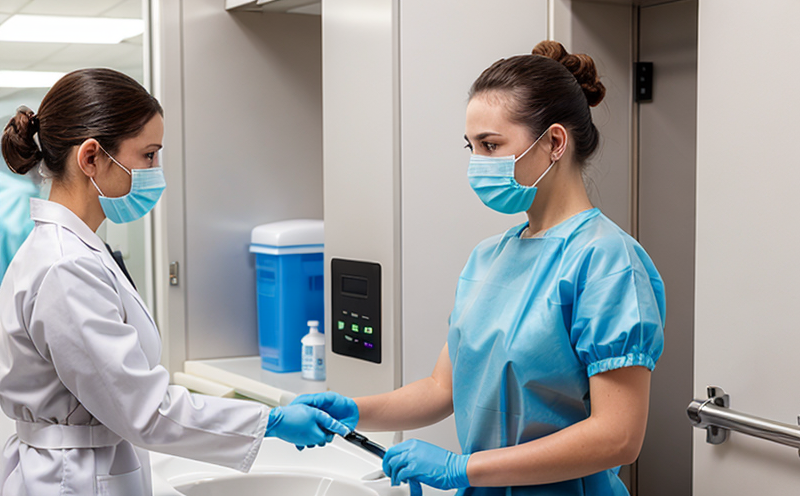AATCC 174 Assessment of antimicrobial activity of carpets
The AATCC Test Method 174 evaluates the antimicrobial efficacy of carpets by assessing their ability to inhibit bacterial growth. This service is critical for manufacturers and quality managers aiming to ensure that their products meet strict hygiene standards, thereby safeguarding public health.
Antimicrobial carpets play a pivotal role in maintaining hygienic environments within residential, commercial, and institutional settings. The global shift towards healthier living spaces has underscored the importance of incorporating antimicrobial properties into textiles like carpets. By employing AATCC 174, laboratories can provide robust evidence that supports the claim of effective microbial control.
The test method involves exposing carpet samples to a standardized inoculum under controlled conditions and then evaluating for any reduction in bacterial colony counts after exposure. This approach ensures consistency across different manufacturers and products, allowing for fair comparisons and informed decision-making by stakeholders.
For procurement teams, this service is invaluable as it helps them select carpets that meet stringent hygiene requirements without compromising on aesthetic or functional attributes. In the R&D sector, AATCC 174 offers a standardized framework to innovate new antimicrobial treatments while ensuring compliance with international standards.
The methodology used in this assessment aligns closely with ISO and ASTM guidelines, providing confidence that results are internationally accepted and comparable. This service is particularly relevant for sectors such as healthcare facilities, schools, offices, and hospitality venues where hygiene is paramount.
Before initiating the test, careful specimen preparation ensures accurate results. Samples should be representative of the product being tested and free from any contaminants that could skew the outcome. Specimens are then inoculated with a specific bacterial strain according to AATCC 174 specifications.
The specimens are incubated under conditions that mimic real-world usage, including temperature, humidity, and exposure duration. Post-incubation, the samples undergo thorough analysis using microbiological techniques to quantify any reduction in bacterial colonies compared to controls.
This process is not only rigorous but also provides actionable insights for manufacturers looking to enhance their product offerings. By understanding how different variables affect antimicrobial efficacy, they can make informed decisions about material selection and treatment processes.
The results of AATCC 174 testing are presented in a clear and concise manner, typically as reductions in colony counts expressed as percentages or logarithmic values. These results serve as proof that carpets meet specified hygiene standards, which is crucial for compliance with regulatory requirements and consumer expectations.
Moreover, the findings can be used to inform marketing strategies, highlighting product benefits such as improved indoor air quality or reduced risk of cross-contamination in shared spaces.
Scope and Methodology
| Step | Description |
|---|---|
| 1. Specimen Preparation | Cut the carpet into standard-sized specimens, ensuring they are representative of the product. |
| 2. Inoculation | Inoculate each specimen with a standardized bacterial inoculum as per AATCC 174 guidelines. |
| 3. Incubation | Expose the specimens to controlled conditions for specified durations, simulating real-world use scenarios. |
| 4. Analysis | Quantify bacterial colony counts before and after exposure using microbiological techniques. |
| 5. Reporting | Present results as percentage or logarithmic reductions in colony counts, accompanied by detailed methodology. |
Benefits
The AATCC 174 assessment offers several key benefits to stakeholders across various sectors:
- Enhanced Hygiene Standards: Demonstrates that carpets meet robust hygiene standards, which is crucial in environments where cleanliness and safety are paramount.
- Increased Consumer Confidence: Provides evidence for marketing claims regarding product efficacy, bolstering brand reputation and customer trust.
- Informed Decision-Making: Offers data-driven insights that help procurement teams select carpets that best meet their hygiene goals.
- Regulatory Compliance: Ensures adherence to relevant industry regulations, reducing the risk of non-compliance penalties.
- Improved Product Development: Allows manufacturers to innovate with confidence, knowing they are meeting stringent standards.
- Potential Cost Savings: By identifying effective antimicrobial treatments early in the development process, manufacturers can avoid costly rework and product recalls.
International Acceptance and Recognition
The AATCC 174 assessment is widely recognized across the globe due to its stringent standards and international alignment:
- American Association Textile Chemists and Colorists (AATCC): Developed and maintained by a reputable organization with extensive experience in textile testing.
- ISO Standards: Aligns closely with ISO guidelines, ensuring consistency across different regions.
- ASTM International: Recognized for its role in developing technical standards for materials, including textiles.
- EN Specifications: Complies with European norms, facilitating ease of trade within the EU and beyond.
- IEC Standards: Aligns with international electrical safety regulations, ensuring comprehensive coverage across multiple sectors.





